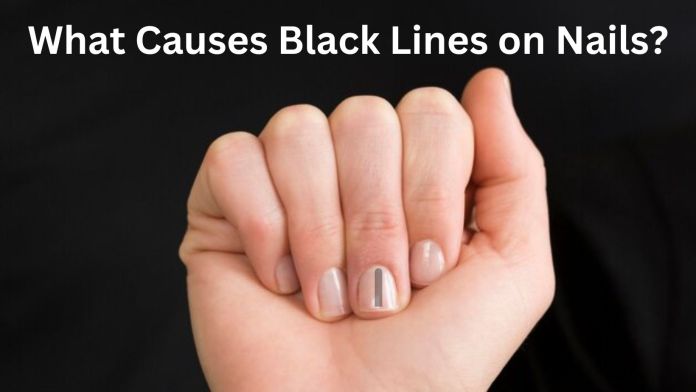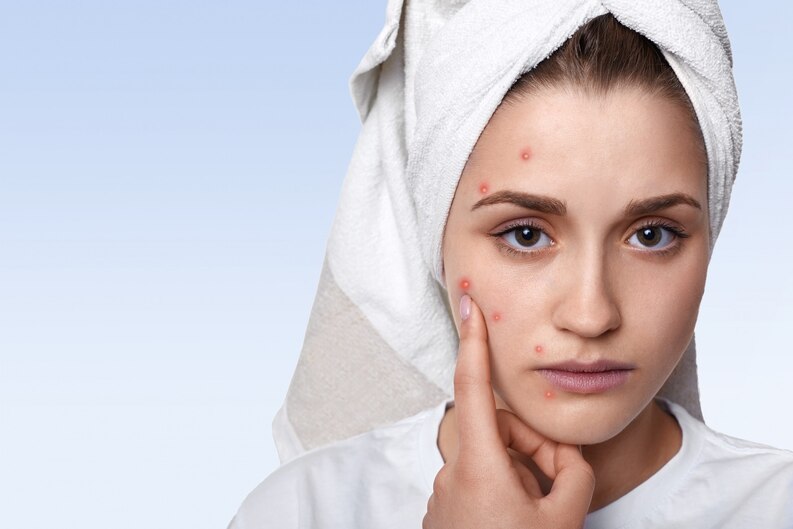Our nails often serve as indicators of our overall health, and sometimes, they can reveal important clues. One particular nail abnormality to be aware of is the appearance of black lines on your nails. This article aims to shed light on why these lines develop, their potential implications, and the steps you can take if you encounter them. Being informed about these matters empowers you to recognize potential issues and seek medical advice when necessary.

Understanding Black Lines on Nails
So, what exactly are these black lines?
Dark lines on your nails can emerge as a result of nail or underlying skin trauma. However, if these lines are thick and cover a significant portion of your nail, it could signal a potentially serious condition known as “Subungual Melanoma.” The term originates from Latin, where “sub” means under, and “unguis” pertains to the nail. Melanoma is a type of cancer that originates in melanocytes, the cells responsible for skin, hair, and eye color.
Typically, this type of cancer is found on the thumb or big toe, but it can manifest on any fingernail or toenail. Unfortunately, these lines are sometimes mistaken for fungal infections, but ignoring them can have serious health consequences.
Why Do Black Lines Appear on Nails?
Black lines on nails can arise from various causes, including:
- Trauma: Injuries to your fingers or toes, such as impact or crushing, can lead to bleeding under the nail, resulting in a black line.
- Excessive Melanin Production: Sometimes, the body produces an excess of melanin, the pigment responsible for coloration in the skin, hair, and eyes, leading to the development of black lines on the nails.
- Medications: Certain medications, such as those used in chemotherapy, may induce black lines on the nails as a side effect.
- Fungal Infections: Fungal infections affecting the nail can alter its color, causing black lines.
- Rare Skin Cancer: Though uncommon, a type of skin cancer called melanoma can also present as black lines on the nails.
Understanding Melanonychia: Malignant vs. Benign
Melanonychia refers to the presence of pigmented lines or streaks on the nails, and it can be classified into two main types:
- Longitudinal Melanonychia: These are vertical lines extending from the base to the tip of the nail. Most cases of longitudinal melanonychia are benign and typically do not pose significant health risks.
- Transverse Melanonychia: In contrast, these are horizontal lines stretching across the width of the nail. The presence of transverse melanonychia may suggest underlying health conditions and should prompt evaluation by a healthcare professional.
Potential Signs and Associated Issues
In addition to visible black streaks on the nails, individuals might experience accompanying indications and complications, including:
- Changes in nail contour, thickness, or texture.
- Fragility or splitting of the nails.
- Discomfort or sensitivity around the nail matrix.
- Lifting or detachment of the nail from its matrix.
- Infection or inflammation of the surrounding skin.
Diagnosis and Evaluation
To determine the underlying cause of black lines on nails, a healthcare provider may undertake the following steps:
- Physical Examination: The medical practitioner will examine the affected nails and inquire about any accompanying symptoms.
- Medical History: They will review the patient’s medical history and inquire about recent injuries or medication usage.
- Biopsy: In cases where melanoma or other significant conditions are suspected, a small nail tissue sample may be obtained for further analysis.
Treatment Options
The approach to addressing black lines on nails depends on their underlying cause. Potential treatment options include:
- Nail Health Support: Promoting healthy nails may involve incorporating vitamin C-rich foods into your diet, as vitamin C plays a crucial role in nail well-being by supporting collagen synthesis.
- Observation: If the black lines are benign and do not cause significant discomfort or complications, specific treatment may not be necessary.
- Trauma Management: When black lines result from injury, proper wound care and nail protection can aid the healing process.
- Antifungal Medications: In cases of fungal infection diagnosis, a healthcare professional may prescribe antifungal medication to eliminate the infection and restore nail health.
- Surgical Intervention: In rare instances involving melanoma or other malignant conditions, surgical removal of the affected tissue may be necessary.
Prevention and Maintenance Guidelines
To prevent the emergence of black lines on nails and maintain overall nail health, consider the following recommendations:
- Safeguard your nails against trauma or injury by using appropriate hand and foot protection.
- Keep your nails clean and dry to prevent fungal growth.
- Avoid prolonged exposure to abrasive chemicals and solvents that may harm the nails.
- Maintain a balanced diet rich in essential nutrients to support strong nail growth.
- Regularly moisturize both your nails and cuticles to prevent dryness and fragility.
Lifestyle Modifications for Nail Health
Incorporating the following changes into your daily life can promote improved nail health:
- Quit Smoking: Smoking can impede blood circulation, which can adversely affect nail health.
- Reduce Exposure to Harsh Chemicals: Limit contact with cleaning products and other substances that may harm your nails.
- Stay Hydrated: Ensuring adequate water intake helps maintain nail moisture and prevents dryness.
- Manage Stress: Prolonged stress can impact nail health, so engage in relaxation practices such as yoga or meditation.
In Conclusion
While the presence of black lines on nails and associated concerns like joint pain may raise alarm, it’s essential to avoid jumping to hasty conclusions. In most cases, these lines are harmless and may result from factors such as injury or increased melanin production. Nevertheless, it remains crucial to remain vigilant about any changes, including joint pain, and to seek guidance from medical experts when needed. By following preventive measures and staying informed, you can maintain nail health and ensure timely intervention when required. Always remember that healthcare professionals can provide accurate assessments and tailored advice for your specific situation, including addressing any concerns related to joint pain.







Leave a Reply